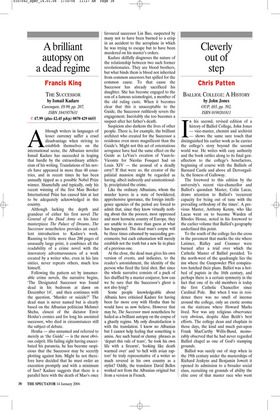Cleverly out of step
Chris Patten
BALLIOL COLLEGE: A HISTORY by John Jones OUP, £65, pp. 392, ISBN 0199201811 In his second, revised edition of a history of Balliol College, John Jones — vice-master, chemist and archivist — shows the same sure touch that distinguished his earlier work as he carries the college’s story beyond the second world war. He writes with easy authority and the book rattles along to its final genuflection to the college’s benefactors, beginning of course with the Balliols of Barnard Castle and above all Dervorguilla, the lioness of Galloway.
The foreword to this edition by the university’s recent vice-chancellor and Balliol’s quondam Master, Colin Lucas, draws attention to Balliol’s ‘recurrent capacity for being out of tune with the prevailing orthodoxy of the times’. A previous Master, Anthony Kenny, who like Lucas went on to become Warden of Rhodes House, noted in his foreword to the earlier volume that Balliol’s geography underlined this point.
To the south of the college lies the cross in the pavement that marks the site where Latimer, Ridley and Cranmer were burned after a trial over which the Catholic Master of Balliol presided. To the north-west of the quadrangle lies the inn where the Gunpowder Plot conspirators hatched their plans. Balliol was a hotbed of papists in the 16th century, and perhaps there is a certain symmetry in the fact that one of its old members is today the first Catholic Chancellor since Cardinal Pole. But when I was in residence there was no smell of incense around the college, only an exotic aroma on the staircase where Howard Marks lived. Nor was any religious observance very obvious, despite Alan Beith’s best efforts. The college dean and chaplain in those days, the kind and much put-upon Frank MacCarthy Willis-Bund, memorably observed that he had never regarded Balliol chapel as one of God’s stamping grounds.
Balliol was surely out of step when in the 19th century under the masterships of Richard Jenkyns and Benjamin Jowett it opened its admission to a broader social class, recruiting on grounds of ability the elite core of that master race who went out from the Thames Valley to run their queen’s empire. Three of Jowett’s pupils in sucession were Viceroys of India, Lansdowne, Elgin and Curzon.
John Jones notes that this tradition of recruitment for public service inevitably brought huge sacrifice in the first world war. More than 900 members of the college went on active service, of whom nearly 200 were killed and another 200 wounded. The average Balliol mortality rate was 22 per cent, double the national average. The younger you were, the more likely you were to die, as infantry subalterns were quickly cut down in the Gethsemane of Flanders. Three Balliol men were awarded the VC, two posthumously, and more than 100 the MC, a dozen of them with bar. Two won the Iron Cross (First Class). It was after all a European civil war.
This bloody harvest, and the imperative of avoiding another, formed the emotional centrepiece of the speech Harold Macmillan made when he came to the college as Chancellor, the year after his doctors had (in his view prematurely) helped to ease him out of the premiership. It was a fine speech, which many of us heard several times over the ensuing years. But you never wanted to complain; it was in a way like listening to Pavarotti repeatedly singing Nessun Dorma. On that particular evening, a few of us were invited back to the Master’s lodgings for whisky and gossip with the old man. He was interested in how we had come to be accepted by Balliol. ‘What did they ask you in your interview?’ he enquired. The answers rather shocked him. ‘In my day,’ he said, ‘all they wanted to know was where you’d got your boots made.’ This is not an approach to admissions policy likely to satisfy ‘OFF-TOFF’, the government’s regulator of social equity in higher education. On the other hand, if followed it might have opened Balliol’s gates to Bill Clinton and Tony Blair, two of the most notable among those who failed to be accepted by this, the college of their first choice. In those days, they may have been attracted by Balliol’s left-wing reputation, though whether that can really have been true of Blair would presumably trigger some debate in the party that today he leads and loathes.
John Jones’s book, part of an admirable OUP series, reminds us of the strength and civilised charm of the collegiate university. Both Oxford and Cambridge have to remember the central importance of the colleges to their standing as preeminent teaching institutions. For their part, one or two colleges have to recall from time to time that, while autonomous and sometimes even ancient, they are part of the wider university. They need the university to do well, just as the university needs them to thrive. The university is more than the sum of its parts.















































 Previous page
Previous page